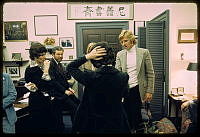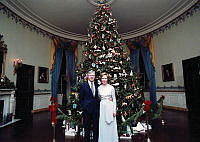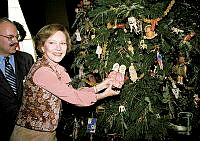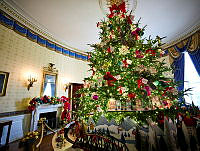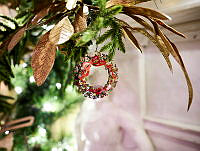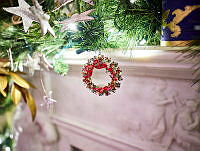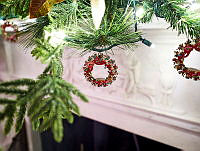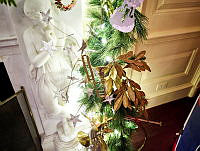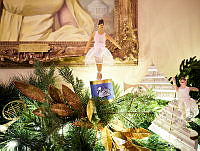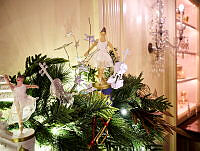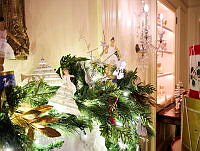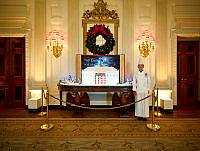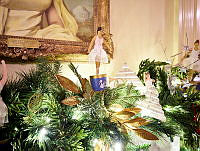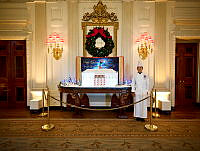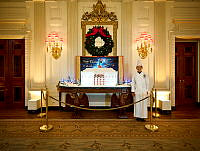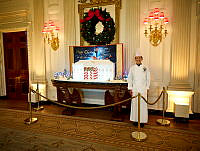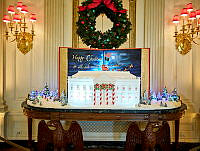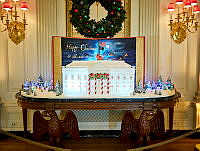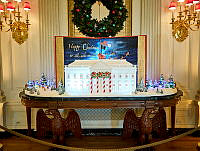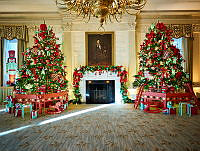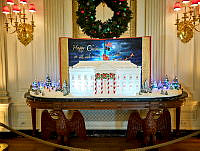The White House Remembered
Recollections by Presidents George H. W. Bush and William Jefferson Clinton
Copyright © Spring 2015 White House Historical Association. All rights reserved under international copyright conventions. No part of this article may be reproduced or utilized in any form or by any means, electronic or mechanical, including photocopying, recording, or by any information storage and retrieval system, without permission in writing from the publisher. Requests for reprint permissions should be addressed to books@whha.org

Hugh S. Sidey is seen here in 1998 in his office at the Time magazine, where he was White House correspondent and bureau chief.
White House Historical AssociationIn 2005, The White House Historical Association released The White House Remembered,Volume 1: Recollections by Presidents Richard M. Nixon, Gerald R. Ford, Jimmy Carter, and Ronald Reagan, edited by Hugh Sidey. The audio edition of this volume, read by the editor himself, is at the bottom of this article. The publication of volume 2, recollections by Presidents George H. W. Bush and William Jefferson Clinton, was delayed by Sidey’s death in November 2005. We now present the two unpublished interviews here, just as they were put into the narrative form by Sidey, in the fitting context of the story of the White House and the press.
Hugh Sidey covered the White House for nearly fifty years, through ten administrations, from the time of Dwight D. Eisenhower to the early years of the George W. Bush presidency. In his introduction to the first volume he explained that we envisioned The White House Remembered “as a continuing series of observations and fresh remembrances by presidents and first ladies of actual life in the White House: the big things and the small things, the great moments of state and the tiny details of daily existence.” His objective, he wrote, was to interview the presidents and the first ladies “after they have spent some years in the White House and have adjusted to its spaces and routines as home but before they are long gone and recall gets fuzzy. We seek the real stuff of history; not only the background and mechanics of White House events, but also the moods and feelings that settled on these extraordinary people once in the White House, and their views of the history of which they have become such an important part.”
Sidey opened volume 1 by reflecting, “I can count nearly fifty years—a quarter of the total life of the White House—of walking up the Northwest Drive in the constant pursuit of news, more of which is funneled through the White House than any other place. And like almost everyone who works in or around the White House for any time at all, I have come to view the building as an enduring and comforting friend in times of tragedy and as a counselor of caution in moments of national euphoria. It always whispers to me, ‘Nothing is as good as it may seem right now—and nothing is as bad as you may judge in the moment.’”
George H.W. Bush
41st President of the United States, 1989-1993
These recollections were compiled and edited by Hugh Sidey, who interviewed the former president in 2000. They are presented here as edited by Mr. Sidey.
Barbara and I had been around the White House—in and out for social
events and meetings—for eight years, so we thought we knew what it would
be like to live there. But we really didn’t. We didn’t know how
marvelous the atmosphere would be and how the staff would instantly
embrace us as family. The minute we walked in as occupants, we began to
sense this wonderful feeling of welcome. It’s not just a house but
also a cherished home, and the longer we were there, the more strongly
we felt that. There is always a certain formality and respect for the
White House because it is the people’s house, and the furniture and
paintings are beautiful and historic. It was not quite living in a
comfortable cabin, but it was still very relaxing. I could come home at
night and pull my tie down. We could come home on Sunday nights and make
our own supper in the little kitchen upstairs. After a while we did
that almost every Sunday so the cooks could be with their families. I’d
tell them to leave out the cold cuts or we would cook an egg or warm up
bagels.
There was also a rapid response team at other times.
For example, one time, I went to church and saw my friend Sonny
Montgomery. I said, “Sonny, come on back and we’ll have some ham and
eggs for breakfast.” I hadn’t told the staff, but with no apparent
strain at all, they had a very nice breakfast ready for us in 20
minutes.
Barbara used to tease me about bringing people home
for dinner or inviting friends over at the last minute. The staff was
extremely understanding of it though. It is so different from being a
cabinet officer or senator because a president is waited on every
minute. If he were so inclined, he might take advantage of the wonderful
services, but we were not so inclined, and I don’t think many
presidents are. We were grateful to the last day for the staff’s service
and affection.
Leaving those people was very emotional for us. On the last day, the groundskeepers, housemen, butlers, and staff were all in the Usher’s Office. They were like family to us. We knew them all by name. I knew their kids were going to school or if they were at home or whose had won a horseshoe match.

This painting by Herbert E. Abrams is President George H. W. Bush's official portrait. He served as president from January 20, 1989 until January 20, 1993. This portrait was officially unveiled at the White House on July 17, 1995.
White House Collection/White House Historical AssociationOne can’t escape history in the White House. And I don’t think anyone
should want to. The clearest reminder of this for me was the Lincoln Bedroom, in which there’s a handwritten copy of the Gettysburg Address.
In that room, Lincoln signed the proclamation that freed the slaves.
On
many occasions, while sitting in the Yellow Oval Room upstairs, I found
myself wondering about Franklin Roosevelt because he had used that room
as his office. We used it for small formal parties. One time we had
dinner up there for some country music people and sports figures like
Chris Evert and her husband.
Just thinking about whatever room
I sat in reminded me of the density of the history of the house itself.
The Treaty Room is one good example. I remember hearing that in the
little sitting room off the Lincoln Bedroom, Nixon and Kissinger said a
prayer. My office upstairs was the old Treaty Room, and there was a
marvelous picture of Lincoln with his commanders. It embodied the
brightness at the end of the war that divided our country. In that room I
had a lot of very important meetings. I can recall meeting there with
Justice Souter. And we had many meetings in there concerning Desert
Storm. I remember sitting in that room once and telling Colin Powell,
who was chairman of the Joint Chiefs, that we had to do something about
the starving children in Somalia because I couldn’t stand thinking about them anymore.
I
have so many memories of that room because I used it as an office up in
the private quarters. I’d come back from the Oval Office or elsewhere,
have a drink, have dinner, then go in there and spend an hour or so
working, dictating, typing little notes, or talking on the telephone.
We
used the
Truman Balcony in several ways. Once in a while I’d have
guests up there for a luncheon so they could see the great beauty of the
place. Any time we had a dinner upstairs, or even a State Dinner, we
would bring the key participants out on the Truman Balcony, even in the
winter, because the view was so striking. Foreign dignitaries who had
seen a lot of our country, or thought they had, were deeply impressed
when they walked out onto it because the vista was fantastic.
We used the Solarium up on the fourth floor to get our grandchildren out of the way. We’d dispatch them to their little kitchenette. They could have a cookout up there, and they also had a television, which had dreadful TV games with falling people, knights being shot down, and other gruesome things.I think they call it Nintendo. They’d go up there though, and we wouldn’t hear from them for a long time. It was great to get some peace.
The public rooms did not become personal during our White House years. We’d watch television in the Map Room sometimes, but there was little warmth to it in a family sense. More often, we’d go downstairs to see how the Christmas tree on the main floor had been decorated. Or we’d take a look at the State Dining Room being fixed up for the next night’s dinner. All of that was ceremonial though, and we didn’t really see that part of the White House as our own.
As I look back on it, the workday didn’t seem all that burdensome even though it was hard to get away. The adrenaline got me going, and I found the job in general very stimulating.
The Oval Office was marvelous. Next to it was a tiny little office that I often used as a dining room. Outside there was small patio where I could lunch or sit in the sun. In the pool house nearby, I had athletic machines: a Stairmaster, a bicycle, and a sauna. Many days, I would work till about 4:00 p.m., go to work out, and then come back for signing mail and finishing up the day. Other days, I would work out or go running at noon and have no lunch to speak of. I’d be gone for maybe an hour and fifteen minutes. For example, I would run at Fort McNair, come back, take a shower, jump in the pool, climb back out, and go back to work. I felt strongly about keeping up my energy level with exercise. In those days, I tried to run 3 or 4 miles four or five times a week.
I loved the competitive part of working out. I was brought up with competition. In the spring, I would invite people over to play tennis on the White House court or at Camp David. Horseshoes was another good way of blowing off steam. Some people don’t understand why the game of horseshoes was so important to me. They thought I was exaggerating my feelings about it, but it truly was a great way to work off the competitive urge. If I went head-to-head with Marvin in horseshoes, I would be in total concentration. I would forget everything else. We could get the whole White House staff involved—the groundskeepers, the Marine pilots, the medical staff, and the Uniformed Secret Service—in our thirty-two-person tournaments. It was great for morale, and I personally loved it. Sometimes families of competitors would come to watch and eat hamburgers by the pool.
I could adjust my day any way I wanted, so I started early. I’d have coffee at about 5:15 a.m. and the dogs would go out. I’d glance through four or five newspapers that were delivered then. Sometimes I’d turn on the TV and watch the 6:30 news, but I’d be out of the residence by 7:15 and in my office by 7:30. Around 6:00 p.m., I’d take some work to do in my office upstairs. There wasn’t any time for reading great literature: I was reading Scowcroft, or NSC, or option papers, or I’d be getting ready for a meeting the next day. As I look back on it, the workday didn’t seem all that burdensome even though it was hard to get away. The adrenaline got me going, and I found the job in general very stimulating.
The physical layout of the White House is perfect. I don’t think there’s anything wrong with living so close to the office. In fact, I think it’s necessary. If a president wasn’t there, he’d spend his time going back and forth in a car or helicopter. I felt the same way about my office at Camp David, which I used a lot. I could go up there at about 2:30 in the afternoon on a Friday, take off my necktie and my suit, put on my khakis, and go down to that little office. I’d spend two or three hours making phone calls, editing letters, and reading. I could get all this done in this friendly environment, undisturbed. It was just me and the telephone to the White House operator. In my own library there won’t be a re-creation of the Oval Office, but a re-creation of the tiny office at Camp David. After working in that office for a while in the afternoon, I’d go for a run in the woods or watch a movie after dinner. In the morning, I’d go there for about three hours and then just relax and play volleyball for the afternoon. That was a great way for a president to do work: there was no press and I never had to worry about how I looked.
I couldn’t think of one single thing I’d want to change about the White House itself. The staff, however, is who really deserves the credit for making the White House what it is.

South Front of the White House by Childe Hassam, c. 1916
White House Collection/White House Historical AssociationBarbara and I loved the grounds. We had these wood ducks that took up residence there, and we kept watch on them. In the evenings we would go out with our dogs, Ranger and Millie, and walk down to the fence to talk to the tourists. They would find it hard to believe that they were talking to the president of the United States on his lawn. They were always very friendly, though, and we learned what the White House meant to them.
We never went out on the north side of the grounds, however. It was always the site of demonstrations, and the shantytown across the way was unsightly. I never should have permitted it to develop, but instead, we just didn’t go on that side of the White House. The South Lawn was where we could find tranquility and beauty.
Down by the tennis court there was a little terrace where we could sit and have a Coca-Cola. We could wander through the little garden where they had handprints of children. There was great privacy and natural beauty there. I’d get very emotional seeing it all from above when I came in on the helicopter, even until the final day of my term.
The White House worked well in crisis. It was designed for it. At those times, I held meetings in the Residence. It was important to have a more intimate setting when secrecy was important. I remember two days before the air war started in the Gulf, I called Tony McPeak, the head of our Air Force, and Secretary of Defense Dick Cheney over for lunch. We could talk business in the Family Dining Room very frankly; it is entirely secure.
I remember when the word came that Iraq had invaded Kuwait. I was down on the first floor in the Medical Room getting a deep heat treatment when Brent came in and said, “We’ve got a hell of a problem.” I had some other things on my mind but that changed in a hurry. We shifted gears. That is how fast and efficient the White House system is.
I loved the White House art. I had a Childe Hassam of a parade with flags in my little study in the West Wing. It was beautiful and patriotic. Upstairs we had a Monet that was bright and airy, and I remember downstairs that was a portrait of Lincoln in the State Dining Room that is known to be extraordinarily strong. It certainly was special. I also always thought that Jackie Kennedy’s portrait was beautiful, very different. The Lincoln picture was the one that moved me the most, though. When I stood before those portraits, it was hard to believe that I was president just as they had been.
I know there is a lot of talk about changing the White House surroundings. It makes sense to me to clean up Lafayette Square so it can be more of a place the American people can enjoy. As it is now, there are too many demonstrators there, and anyone with a cause or a complaint who wants to use it uses it. I think we’ve been too permissive with it given the unpredictable political climate we live in. Getting rid of the traffic on Pennsylvania Avenue in front of the White House would also be a good thing. Another idea is to have the press in another corner of the house so it’s not turned into a backdrop for commercial television.
I loved the South Lawn ceremony when I would greet foreign dignitaries. They seemed to like it, too. It was tasteful setting: we would hold the arrival ceremony and the short greetings, then go into the house for a warm environment in which to have coffee or tea. Afterwards, I could walk a short distance to the Oval Office to get to work.

Guests seated with President George H.W. Bush and Queen Elizabeth at a state dinner held in the Queen's honor, May 14, 1991.
George H.W. Bush Presidential Library/NARAThe State Dinners we gave were quite wonderful, especially because they were so formal. It was a chance to invite visitors, officials, and friends into a very glamorous, yet not overdone, setting. The staff did it just right, and the entertainment community was very generous in agreeing to perform there. We had some enchanting evenings, and the people who came seemed to enjoy them very much.
Historians would occasionally come to talk about the presidents. They were excellent, but there was never adequate time. I’d go listen, but we never truly could pick their brains.
Sometimes I felt a little overburdened by ceremonies, but it was important to perform them, and they were usually easy anyway. The Rose Garden was a marvelous facility for that. A president can just walk out of his door onto it. What a beautiful setting. We had some huge affairs on the South Lawn, like the Americans with Disabilities Act signing, a very emotional day, an event for the Special Olympics, and a barbecue for members of Congress, who loved coming in. I always loved seeing people enjoy themselves at the White House.
Sometimes it seemed like we made the clock go thirty-six hours in the White House, but I’m not a believer in the theory that the job is too big and can’t be done by the president and his advisers. I don’t think it needs structural change. So much depends on the people recruited and your confidence in those people. A president can design the best system in the world, but none of it matters more than the quality of the people. They make the job into a task possible for the president to do.
I lived for those security briefings in the morning, in which I put great faith. The briefer had worked all night to put together the material, and he would come down and give it to me. I would sit with the guy and say, “What the hell does this mean? We’re not certain this is a MiG-25 or that Gorbachev is missing? How can you say that?” I would ask them, and they’d go back for more. Those briefings brought me up to speed. I could never complain about the burdens of the presidency under a system so finely tailored by time.
William Jefferson Clinton
42nd President of the United States, 1993-2001
These recollections were compiled and edited by Hugh Sidey, who interviewed the former president in 2001. They are presented here as edited by Mr. Sidey.
Many great people have called this house home. All of them, so far, have been white males of European descent. I am absolutely convinced that in the near future there will be a woman president, and a person of color will occupy the White House and the Oval Office. The presidency was not built by one person; in a fundamental way, it has been carried forward by the American people since the beginning.
I have spent a lot of time reading the histories of the various periods in the White House and the biographies of some of my lesser-known predecessors. These histories include a mixture of the personality, character, and skills of a president; his time; and also a sense of what personal joys and tragedies surrounded presidents.
Just for example, Franklin Pierce, one of the only other presidents who came from a small state and was governor beforehand, generally didn’t hold a good reputation as president. However, I wonder if even Lincoln could have succeeded in 1853 instead of 1861. Almost never do I hear anyone mention the story of Franklin Pierce on his way to his inauguration. With his wife and his only child, he took the train from New Hampshire to Washington. There was a minor accident in which 10 or 11 people received minor bruises, but his son fell on his head, cracked his spine, and died. Neither he nor his wife ever recovered.
Abraham Lincoln would have a hard time getting elected today because he had terrible, periodic but persistent bouts of depression. He was married to a wife who was bubbly and strong and happy and, as far as I know, has the distinction of being the only woman in American history to have been courted by three of the four candidates for president in 1860. John Breckinridge and Stephen Douglas also pursued her, but clearly she made the right decision.
The Lincolns lost a child before they came to the White House. They lost another child there. She lost three half-brothers fighting for the Confederacy. All the carnage of the Civil War and the burden of the tragedies they faced broke Mary Todd Lincoln, and in history she is seen as a very different person from who she really was most of her life. In some magical way, all the personal and national trauma of that time was absorbed by Abraham Lincoln in a way that enabled him to become stronger, to overcome his own demons, to leave aside his own depression, and to become, in my view, the greatest president we ever had.
Rutherford B. Hayes was one of four or five Union generals from Ohio who became president. After the Civil War, a Union general from Ohio had about a 50 percent chance of becoming president. It’s the only period in our history that has ever been like that. A lot of the rest of us wish it had been so easy.
Theodore Roosevelt once complained that he would never be viewed as a great president because he had the misfortune of serving when there was no great war. He couldn’t have been more wrong. And I’m convinced his temperament was perfectly suited to the time in which he served. Ironically, although he complained about having no war, he’s one of only two presidents ever to win the Nobel Prize for Peace. It goes to show that a president must show up to do his best and make do with anything that comes his way.

This portrait of President Bill Clinton was painted by renowned artist Simmie Knox in 2004 after Clinton left office. Knox, who also painted a portrait of First Lady Hillary Clinton, became the first African American selected to complete an official White House portrait. A former governor of Arkansas, Clinton served as president from January 20, 1993 until January 20, 2001.
White House Collection/White House Historical AssociationThe East Room has not only witnessed historical events; it has played a role in shaping them. It has hosted forty-two administrations and forty-one different personalities—every president except George Washington. The East Room began as a laundry room of Abigail Adams—an auspicious beginning—reminding us that there are certain basic elements of life that don’t disappear just by becoming president.
Thomas Jefferson and Meriwether Lewis laid maps and animal skulls on this floor and charted the Lewis and Clark expedition. Later in 1814, a banquet was held in the White House during which James Madison sent Dolley word that the army had miscalculated where the British were going to assault Washington. He told her to cut Gilbert Stuart’s painting of George Washington down and get out of the house as quickly as possible. She did, and they had to leave the banquet. The British came in, ate the food, then set fire to the house.
Later, the house and this room were the headquarters for the battle-worn Union troops during the Civil War and later, the roller skating rink for Roosevelt’s children. Over the years, the house has survived a major fire, two wars, a plane crash, and five weddings. And, of course, it has been a gallery for some priceless art that embodies the history of this country.
Each president in his own time has survived unique challenges, striving to fulfill the purpose of our Founders to form a more perfect union.
When I first arrived in the White House, I wanted to get upstairs and look around. I had only been upstairs twice before, once under President Carter and once under President Bush. I wanted to feel what it would be like. I have to say that even after years as president, I still felt a sense of awe every time I entered into the place. I felt the weight of history there. I would go into each room and try to know what important things had happened in it. Living in the White House was a great blessing, and I think it helped me be a better president because I felt I was carrying on a continuous conversation with all my predecessors and with many of the great dramas of American history.
I know what happened in the room I used as my office. It is the room where Andrew Johnson moved the office of the president after Abraham Lincoln was assassinated. And it was the principal office until 1902, when Theodore Roosevelt built the West Wing. In 1898, the treaty ending the Spanish-American War was signed there on a table bought by General Grant when he became president. For a hundred years, every peace treaty has been signed there. To live and to work every night and on the weekends in a room called the Treaty Room on a table called the Treaty Table that Ulysses Grant brought here in 1869 is incredible. It never ceased to give me a great feeling.
After living there, I changed my mind about quite a number of presidents. I think conventional wisdom about a number of them is wrong. Grant was a better president than most people believe he was. He had corruption in his cabinet and he had a brother that tried to take advantage of him, but he basically was a better president than he got credit for. He was also a phenomenal general, and he wrote the best presidential memoirs by far. The Yellow Oval Room was laid out as it is now by President and Mrs. Kennedy. It was Roosevelt’s study during World War II, where he worked in the evenings when he didn’t go down to the Oval Office. Indeed, he slept in that room so he could wheel himself in. He also built the Jefferson Memorial with the statue of Thomas Jefferson looking right through the window where his desk was so he could look at him for inspiration.
I felt the history of the room. Jackie had a very good reason for wanting to fix it up. When foreign visitors or people from other states come, a president needs a formal meeting room, but there’s no place to bring them except the formal rooms downstairs. The Yellow Oval Room is functional for this purpose.

President Clinton was especially interested in how his predecessors used each room in the White House. He observed that "the East Room has not only witnessed historical events; it has played a role in shaping them."
White House Historical AssociationI haven’t seen or heard any ghosts in the White House, but I’ve been into the Lincoln Bedroom at several times trying to find Lincoln’s ghost. He’s never presented himself to me.
There was a big dispute on whether the original White House plans included the balcony that Harry Truman had put in. There was also a huge amount of adverse comment by people who thought the balcony was going to spoil the look of the house, but I can say as someone who has lived there, it dramatically increases the quality of life for the first family. In the springtime we would put furniture out there, and every weekend we were in town we spent some time on the balcony. It was wonderful.
Up on the Second Floor of the White House one can walk and look around the office that every president between Andrew Johnson and Theodore Roosevelt occupied, except Lincoln, who used it as a waiting room. And if you go into Lincoln’s Bedroom, you’ll realize that it was his office and he signed the Emancipation Proclamation there. The little room behind that was Woodrow Wilson’s office during World War I, where he ran the war and where the first telegraph and telephone in Washington, D.C., were located. I had to think about the things that happened and the decisions that had been made in that house, and it made whatever mine were seem both do-able and bearable. It kind of lifted me.
No one made any of us become president. Every one of us asked to do it, and it’s a great privilege and honor. Even the bad days are good because we’re given the chance—as President Kennedy once said—to bring together all of our own powers of thinking and doing and persuading in a way that no other job in the world could do. Some presidents like to complain about it, but to most of us it’s a phenomenal opportunity. When the drenching news coverage of the day comes along or when things are not going so well, people say, “Gosh, it must be terrible,” and I respond, “Even the bad days are good.” And they are, every one of them.
I’m amazed at how many presidents, beginning with George Washington, complained about how hard it was to be president, and how all their motives were suspect. George Washington said that once he got to be president, people treated him like a common criminal.
And of course, in the beginning of the country, the politics were about as rough as they are now. The three periods that have been most partisan were, in the beginning, Jefferson and Adams; then around the Civil War; and now our own time.
Harry Truman referred to the White House as a “great white prison.” And if he was serious, I must say I disagree with him. The rough times there—and I’ve had some pretty rough times—are just part of the cost of doing business. The job is a joy. It’s a gift to be able to do this kind of work.
I had to think about the things that happened and the decisions that had been made in that house, and it made whatever mine were seem both do-able and bearable.
It is really quite a wonderful place to live as well. There’s a swimming pool, and Hillary and I spent a lot of happy days there just talking and reading. On Sunday afternoons, we would go up to the Truman Balcony. You can get busy and drift apart, but for us, we had more time together there than we had before. We have always had a lot of things to do.
In the early years of my term as president, our daughter was finishing up junior high school and high school, and we were together at night quite often. We talked about her schoolwork and what was going on in her life, and that was a lot of fun. After Chelsea left and went to college, we were able to go to Camp David more.
I miss Camp David, the Marine Band, and flying on Air Force One. I miss working in the beautiful office. It’s the most beautiful place I’ve ever worked because of the shape of the room and the size of the windows. There was always light there, even when it was raining outside. I miss a lot of things, but the thing I miss more than anything else is the chance to work for the American people every day. It is a joy.
I feel grateful for some of the things that have been passed down to me. The day before I became president, I received a copy of the only book that Thomas Jefferson ever wrote, Notes on the State of Virginia, a book remarkable for its incredibly detailed analysis of everything about the state. It is most important today because it contains the first known recording of Thomas Jefferson’s condemnation of slavery. It always struck me that every person in this job must live with a certain ambiguity, and I wonder how he dealt with it. I’m grateful for what he left us.
Shortly after I assumed office, Pamela Harriman gave me the ink blotter that President Kennedy used in his office in the White House. Mrs. Kennedy had given it to her husband Averell, about twelve days after President Kennedy was killed, with the letter that Jackie Kennedy had written. Because it was my great good fortune to know Jackie and her children, it is one of my most precious possessions. About once a month I open the ink blotter and read the letter again, just remember how fleeting life is and what a great gift every day is.
I think one of the most treasured pictures I have from my time in the White House is the picture I have of young John Kennedy looking at his father’s portrait on a visit he made here, when he had a wonderful preview here of the great series on space HBO did.
So the history of the country goes on, and the first families come and go. For all of their achievements and all of their failures, they were also people. The great premise of democracy is that ordinary people will make the right decision most of the time; that no one is irreplaceable, but that freedom is.
The White House Remembered: Presidential Reflections
These interviews with Presidents Richard M. Nixon, Gerald R. Ford, Jimmy
Carter and Ronald Reagan were compiled and edited by Time magazine
White House correspondent Hugh S. Sidey for the White House Historical
Association. The goal was to get observations and recollections of their
times in the White House—the big things and the small things, the great
moments of state and the tiny details of existence.
Introduction to The White House Remembered: Recollections by Presidents Richard M. Nixon, Gerald R. Ford, Jimmy Carter, and Ronald Reagan.
These interviews with Presidents Richard M. Nixon, Gerald R. Ford, Jimmy Carter and Ronald Reagan were compiled and edited by Time magazine White House correspondent Hugh S. Sidey for the White House Historical Association. The goal was to get observations and recollections of their times in the White House—the big things and the small things, the great moments of state and the tiny details of existence.
Hugh S. SideyThe White House Remembered: President Richard M. Nixon
Richard Nixon served as the 37th President of the United States from 1969 until his resignation in 1974. Hugh Sidey met with him in his home in Woodcliff, New Jersey in 1993 for lunch and conversation and remembers he talked for a long time that day. Nixon seemed to remember every sound, sight and corner of the White House.
Hugh S. SideyThe White House Remembered: President Gerald R. Ford
Gerald R. Ford served as the 38th President of the United States, from 1974-1977. Hugh Sidey interviewed the president at his office in Palm Desert, California, nearly 40 years after the president left office. His memories of his time in the White House are read here by Hugh Sidey.
Hugh S. SideyThe White House Remembered: President Jimmy Carter
Jimmy Carter served as the 39th President of the United States from 1977 to 1981. Hugh Sidey conducted this interview with him in the mid-1990s and explains former Presidents are in some ways more harried than the sitting president. Sidey's interview with President Carter had to be over the phone because of his global itinerary.
Hugh S. SideyThe White House Remembered: President Ronald Reagan
Ronald Reagan served two terms as president of the United States from 1981 to 1989. Hugh Sidey interviewed the former president in Los Angeles shortly after he left office, and observes that despite the tragedy of the early onset of Alzheimer's Disease, the text of the interview contains the old Reagan sparkle and humor and the reverence for the White House and the wonder at ever having arrived there.
Hugh S. Sidey













